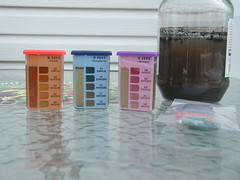
A soil test provides good intel on how suitable your garden's soil is for the plants you want to grow. I didn't do one last year after building my garden (when I should have) and finally got to it a few weeks ago.
I've been reading an excellent gardening book called
The Vegetable Gardener's Bible by Edward C. Smith which has several pages on soil tests and what to do with the results. I was wary of using a home test kit but Smith recommends it for most soil testing and a full lab test when building a new bed or making major changes to an existing one. Since labs are busiest in spring, he also says you can get quicker lab test results in late summer or fall when the labs aren't so busy.
Unlike a lab test which provides data on many soil nutrients, a home kit only tests the four things that make the most impact on your plants...acidity (pH), Nitrogen, Phosphorus and Potassium levels. I wanted quick test results in order to make changes to improve this year's crop and got a home test kit.
The test is easy to take. Dig up soil, pick or sift out the big pieces and add distilled water. Use distilled water to prevent minerals in your tap water from skewing the results. The test kit includes color coded vials and powders to use for each test. The pH test is done right away by adding the soil, water and powder directly to the vial and shaking. For the nutrient tests, you have to mix the soil and water in another container first and wait for the soil to settle out. Then you mix the water and powder in the vial.
The powder reacts with each sample and will change color depending on the level. A color indicator chart on each vial tells you what the result is. Simply match the color of the test sample to the color on the chart.
The Results...
pH - Soil Acidity
The pH test result was in the 7.0-7.5 range. That's neutral to alkaline which is ok but not optimal. The sweet spot for most vegetables I plan to grow is around 6.5.
I added peat moss and dead leaves to increase the acidity. Of course two days later I read that
using peat moss isn't environmentally friendly. Well, I can't return it back to the bog. I'll look for other options next time.
N - Nitrogen
The first key nutrient test and I flunked. No color change at all. That means the Nitrogen in the soil is depleted and my plants will be lucky to grow at all.
I added a couple bags of organic compost (which I planned on getting anyway) and worked in some fresh grass clippings. Hopefully that will be enough otherwise I'll have to buy blood meal or some other organic fertilizer. I'm trying to avoid adding any commercial fertilizers unless necessary.
P - Phosphorus
Bombed this one too. To increase the Phosphorus I bought a 10lb. bag of rock phosphate and added half of it to the garden. Smith recommends occasionally throwing a little rock phosphate into your compost pile to keep the garden's phosphorus level up over time. I might try that.
K - Potassium
I nailed this one! The test results showed a surplus of potassium (it's the orange one in the picture...ain't it pretty?). From what I read it doesn't sound like a surplus of this nutrient will do any harm so no changes needed.
Based on the test results I've made some changes to the garden's soil and I'm ready to start planting. I'll test again in the fall (maybe a full lab test) to give more time for any needed changes to take effect.
 Plants can surprise you. Last year I planted a little oregano plant. It did well and we enjoyed fresh oregano all summer long.
Plants can surprise you. Last year I planted a little oregano plant. It did well and we enjoyed fresh oregano all summer long.
